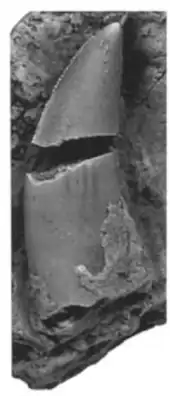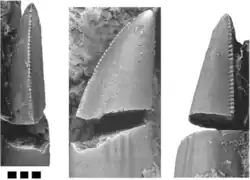Picrodon
Picrodon is the name given to a genus of archosaur, possibly a sauropodomorph dinosaur,[1] from the Rhaetian of England which was possibly synonymous with the dubious archosaur Avalonianus. The type, and only species, P. herveyi, was named in 1898.[2]
| Picrodon Temporal range: Late Triassic, | |
|---|---|
 | |
| Holotype tooth | |
| Scientific classification | |
| Domain: | Eukaryota |
| Kingdom: | Animalia |
| Phylum: | Chordata |
| Class: | Reptilia |
| Clade: | Archosauria |
| Genus: | †Picrodon Seeley, 1898 |
| Species: | †P. herveyi |
| Binomial name | |
| †Picrodon herveyi Seeley, 1898 | |
Discovery and naming

In 1894, W. A. Sanford described the fossil remains of what he considered to be two large reptiles discovered near Westbury-on-Severn, Glastonbury (Westbury Formation) by Eev. Sydenham H. A. Hervey and Sanford himself.[3][2] Harry Govier Seeley described the fossils and named two genera: Avalonia (preoccupied; now Avalonianus) and Picrodon; both are based solely on teeth.[2]
Only a single tooth, holotype BMNH R2875, belonging to P. herveyi is known, making the remains not sufficient enough to make judgments on its diet or its classification; although it is agreed that Picrodon was an archosaur to some degree.
Classification
Sanford (1894)[3] classified Picrodon as a reptile, while Seeley (1898)[2] classified Picrodon as a saurian. More modern research however almost certainly places Picrodon within Archosauria; Peter Malcolm Galton (1985) suggested that Picrodon may have been a basal sauropodomorph. Currently, its exact phylogenetic placement within Archosauria remains unknown.
References
- Galton, Peter M. (1985). "Notes on the Melanorosauridae, a family of large Prosauropod Dinosaurs (Saurischia: Sauropodomorpha)". Geobios. 18 (5): 671–676. doi:10.1016/s0016-6995(85)80065-6. ISSN 0016-6995.
- H. G. Seeley. 1898. On large terrestrial saurians from the Rhaetic Beds of Wedmore Hill, described as Avalonia sanfordi and Picrodon herveyi. Geological Magazine, decade 4 5:1-6
- Proceedings of the Somerset Archaeological Society - vol. xl, 1894, p. 234